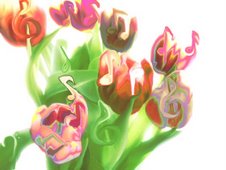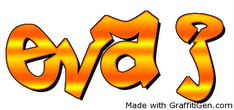Thursday, May 3, 2007
Some Final Comments
Winding Down Comments
I noticed http://www.laflutedecherry.com had a cool design. The concept of a tour of the city is a nice one. I think that she and I have the same startlogic host the vDeck logo keeps appearing. I think it's great that she actually got the guest book to work...I couldn't seem to manage that feature with our host.
http://www.domenicafossati.com/
This concept turned out nicely. Domenica, you seemed a little uncertain in class, but it turned out so well. I love how the different vertical texts fade in and move slightly with the mouse-overs.
Darn Flash Buttons
Tips, Problems, and Hard Lessons Learned...
Flash Buttons: So the moral of the story is that naming an instance is important.
Behaviors: You actually have to press the + button and add the behavior for the button to work.
Uploading the SWF file is actually important. Don't forget to do that.
Oddly enough, 'Danby' or 'Sweet Rain' used the same buttons on her blog that just killed me.
The Adobe site can be helpful, but it might provide way more info than you need, or are actually ready to handle. Here it is anyway: http://www.adobe.com/support/flash/
Flash Buttons: So the moral of the story is that naming an instance is important.
Behaviors: You actually have to press the + button and add the behavior for the button to work.
Uploading the SWF file is actually important. Don't forget to do that.
Oddly enough, 'Danby' or 'Sweet Rain' used the same buttons on her blog that just killed me.
The Adobe site can be helpful, but it might provide way more info than you need, or are actually ready to handle. Here it is anyway: http://www.adobe.com/support/flash/
Using eChalk with Students
It seems like every school hosts their website with eChalk. Many NYCDOE schools do, and so do a lot in the suburbs. I was speaking to Sandy Scrag, of the Teachers Network, about this and she explained. Apparently eChalk used to be free, and then after everyone set up their free website they started charging money (cute trick-if true). Our school has a site hosted by eChalk. I remember when we did the training, some of my colleagues thought it was the best thing since sliced bread, and others were scared to death. I find that in classes where literacy levels are adequate, and most of the class is comfortable with the English Language, it is a great tool. I post information for two classes: Electronic Music Composition, and Music Technology II. The resources section is great. I find that some students need reminders with some of the same skills, such as cabling Logic's environment window, and all I have to do is post the notes and it saves tons of time. Here is the link to my school's eChalk site. When you get to the page, select "class pages"->"music"->pick either of: Electronic Music Composition&Music Tech.II
Digital Immigrants Digital Natives
Recently, I've been taking a psychology of music class. Be mindful that these excerpts are copyrighted materials. Here are some of my writings from this class:
New York State requires all students to complete one semester of music to graduate from high school. What is to be done with the large numbers of non-musicians that are tossed into the music classroom? There are a myriad of options. In years past, when the Music Education as Aesthetic Education movement was in full swing, these students were made to listen to recordings, and learn about the 'elements of music', and a little history. Some schools in more recent years have adopted a Praxial approach in which students engage in making music. One thing that is commonly excepted is that musical expretise takes practice, and implicitly, a long time. It would be difficult to achieve a high level of musicianship in one semester (of course that may not be the goal). How can large numbers of students create or make music in a way that they deem aesthetically pleasing in a relatively short amount of time? Part of the answer lies in the use of technology....
In the past twenty or so years there has been a digital revolution. The ways in which people process and disseminate information have changed dramatically. Research shows that people who have grown up with this technology, and are native to it, think in ways that are different than those digital immigrants who have not. There have been recent developments in terms of affordable hardware, and sophisticated software that readily allow those that have previously considered themselves nonmusicians to make music...
Students who are in school now are in a unique position because they have been born into the age of the digital revelution. There are certain characteristics of learners who have been born into this era, and those who have not. The learning of music in this era should reflect the technology and the modes of learning to which these students have grown acustomed. Furthermore, the years of music theory, and verbal/linguisitc learning previoulsly considered a prerequisite to making music have been diminished, if not overcome, by developments in music technology. This recent technology combined with student's enculutrated musical knowledge, and their educational bias as natives of the digital era suggest it is time for music educators to reevaluate their methedologly.
New York State requires all students to complete one semester of music to graduate from high school. What is to be done with the large numbers of non-musicians that are tossed into the music classroom? There are a myriad of options. In years past, when the Music Education as Aesthetic Education movement was in full swing, these students were made to listen to recordings, and learn about the 'elements of music', and a little history. Some schools in more recent years have adopted a Praxial approach in which students engage in making music. One thing that is commonly excepted is that musical expretise takes practice, and implicitly, a long time. It would be difficult to achieve a high level of musicianship in one semester (of course that may not be the goal). How can large numbers of students create or make music in a way that they deem aesthetically pleasing in a relatively short amount of time? Part of the answer lies in the use of technology....
In the past twenty or so years there has been a digital revolution. The ways in which people process and disseminate information have changed dramatically. Research shows that people who have grown up with this technology, and are native to it, think in ways that are different than those digital immigrants who have not. There have been recent developments in terms of affordable hardware, and sophisticated software that readily allow those that have previously considered themselves nonmusicians to make music...
Students who are in school now are in a unique position because they have been born into the age of the digital revelution. There are certain characteristics of learners who have been born into this era, and those who have not. The learning of music in this era should reflect the technology and the modes of learning to which these students have grown acustomed. Furthermore, the years of music theory, and verbal/linguisitc learning previoulsly considered a prerequisite to making music have been diminished, if not overcome, by developments in music technology. This recent technology combined with student's enculutrated musical knowledge, and their educational bias as natives of the digital era suggest it is time for music educators to reevaluate their methedologly.
Cablevision Award Finalist
Around one month ago I found out that I've made it to the finals for the Cablevision Leaders in Learning Awards in the category of Media Literacy. Here is their website: http://i.ciconline.org/LIL/Finalists2007.html
For this grant, Cablevision wanted a unit with examples of student work that promoted Media Literacy. I submitted the Album Project, which is an end-of-year portfolio album of student's music. Essentially, my music technology students have to create an album of their own original composotions, the artwork, a short music video, and a promotional media plan. It works well for a portfolio assessment. The description of the requirements are online.
For this grant, Cablevision wanted a unit with examples of student work that promoted Media Literacy. I submitted the Album Project, which is an end-of-year portfolio album of student's music. Essentially, my music technology students have to create an album of their own original composotions, the artwork, a short music video, and a promotional media plan. It works well for a portfolio assessment. The description of the requirements are online.
Teacher's Network Grant Winner!
About a week ago I found out that I have received a Teacher's Network Grant!!! I have won one from them before, and they are a very generous organization. They are a great resource for teachers that are looking for lesson plans, and a great resource for teachers that are looking to write grants and win money. Here is the link to my submission: http://www.teachersnetwork.org/grantWinners/TeachnetDisseminator_EvaEgolf.cfm
I have another unit online with the Teachers Network. If you search for my name, you'll find it.
I have another unit online with the Teachers Network. If you search for my name, you'll find it.
Subscribe to:
Comments (Atom)

